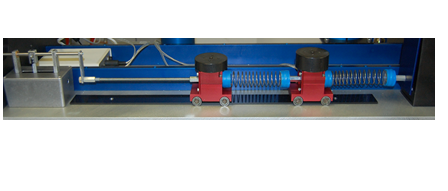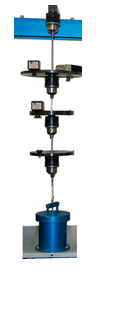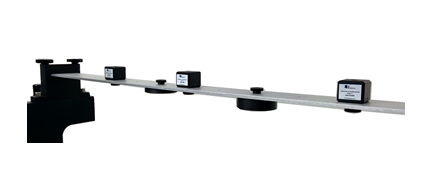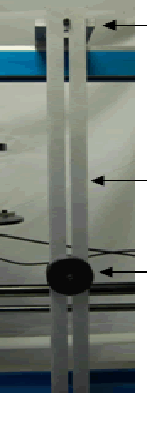Vibration Fundamentals Training System
An Ideal Tool for Optimizing Your Vibration Class Curriculum
Description:
The
Vibration Fundamentals Training System (alias VFT) is a turn-key
integrated educational package for teaching/learning the fundamental
principles of mechanical vibration as well as engineering mechanics. It
provides both a comprehensive hands-on experimental device and an
instrumentation package including wireless sensors for performing
laboratory exercises to enhance student understanding of vibration
theory.
-
Descriptions
An Ideal Tool for Optimizing Your Vibration Class Curriculum
The VFT clearly brings classical theory to life by providing a convenient mean to validate predictions and to demonstrate the influence of parameter changes on system response visually. Students can perform virtual experiments using the vibration simulation software and then verify the results with actual experiments thereby reinforcing the learning of difficult principles. The VFT provides an ideal tool for damping free vibration experiments using the wireless sensors without affected by the damping associated with the sensor cables. It is a perfect tool for teaching mechanical vibration courses both at under graduate and graduate levels.
With an increase in high speed manufacturing and automation, it has become more important to use the theory of vibration for design and maintenance of machinery. This vibration theory is even more important in the monitoring and diagnosis of machinery malfunctions. Considering the importance and complexity of vibration principles, a course curriculum should include laboratory demonstration and hands-on experiments to help students understand the somewhat abstract concepts of vibration. To this date, most academic institutions include only theoretical lectures without laboratory exercises due a lack of an apparatus combined with an instrumentation setup. With SpectraQuest’s VFT, this deficiency has been resolved making hands-on vibration teaching now possible.
Controlled Experiments Expedite the Learning
SpectraQuest’s Vibration Fundamentals Training System (VFT) is an innovative tool you can use for teaching the fundamental principles of mechanical vibration. The VFT is well researched and designed for immediate implementation for vibration laboratory development. It is can be easily integrated with a typical vibration course taught at most institutions. The VFT provides a comprehensive hands-on experimental device, an instrumentation package, and experimental program with course curriculum for performing laboratory exercises to enhance student understanding of vibration theory. The bench-top apparatus has a spacious modular design featuring versatility, operational simplicity, and robustness. Each component is machined to high tolerances so it can be operated without conflicting vibration in a totally controlled environment. The instrumentation package includes wireless less accelerometers and transducers, precision servomotor for excitation, tachometer, and four channels simultaneously sampled data acquisition hardware, signal conditioners, and time and frequency domain analysis software. Also included are a software simulation of theory and a well-defined experimental program for free and forced vibration experiments ranging from single degree of freedom spring mass to continuous beam with different boundary conditions.
Students can perform both hands-on and virtual experiments to optimize the learning. The VFT is designed to perform both free and forced vibration experiments with and without damping. The basic VFT frame consists of two identical test stations mounted on a portable structure. It features into changeable restraint fixtures, optional force transducers to measure the support reactions, sensors to measure deflection and acceleration, and a variable frequency rotary shaker for forced excitation. It allows for the first time to perform almost damping free vibration experiments tp verify the theory using SpectraQuest in-house developed wireless sensor technology. -
Advantages
Advantages
• Clarify difficult concepts of vibration theory by performing hands-on controlled experiments
• Perform both free and forced natural vibration experiments without damping for the first time using SpectraQuest developed wireless sensors.
• Validate theoretical predictions of natural frequencies, mode shapes, and frequency response as a function of frequency, boundary conditions, geometry, and materials
• Validate theoretical concepts by comparing experimental results with the computer simulation of the vibration theory
• Determine the detrimental effects of vibration load transmission to the support structure and component fatigue life
• Learn to control vibration amplitude using tuned mass dampers and damping treatments
• Learn vibration measurement transducers, signal processing, data acquisition and data analysis
-
Features
Features
• Fully integrated turn-key package consisting of comprehensive experimental device, wireless sensors, data acquisition instrumentation, analysis software, course curriculum, exercise book, and simulation software for virtual experimentation
• Robust, user friendly, modular, and compact bench-top device for performing controlled experiments
• Experimental setup for single and two-degrees of freedom spring-mass system (with and without damping)
• One and two-degrees of freedom torsional vibration (with and without damping)
• Vibration control experiments with viscoelastic damping and tuned-mass-damper
• Full experimental setup for beams with different boundary conditions, material, geometry, and length to understand effects on natural frequency and mode shapes
• User friendly software with pre-defined experiments integrated with data acquisition and data analysis
• Virtual experiment capabilities to learn the effects of parameters for each type of test configuration
Wireless Sensors Simply Experimentation and Enhance Learning ExperienceCables are often a source of problem due to entanglement and damping associated with them. Cables require special handling during any experimental procedure. They also created hard to characterize unwanted damping. Both of these issues have been solved by SpectraQuest VFT system. We have developed wireless sensors that eliminated both of these problems. Our proprietary algorithm enables simultaneous acquisition of data from all sensors, thus making it possible to obtain accurate phase information and the mode shapes.
Data Acquisition and Analysis InstrumentationThe VFT is equipped with wireless transducers, SpectraQuest’s proprietary 4 channel simultaneously sampled data acquisition (DAQ) system; data analysis software with automated setup for performing each experiment, simulation software, motor control module, multi-featured display, and mounting hardware/tooling. Transducers are provided for the measurement of acceleration, force, and rotational speed. The DAQ system samples all channel simultaneously enabling accurate calculation of mode shapes. Easy to use software automates steps to conduct each experiment and display the results. Students can perform time and frequency domain analysis, read data to do calculations and compare them with theoretical predictions.
The DAQ hardware/software is fully integrated with the excitation motor operation and control. The user can send speed command to control the excitation frequency or a sine sweep can be applied to obtain the full frequency response information over the frequency range of interest. All experimental and data collection setups are pre-defined so that students can focus on the results. The user friendly software is a powerful tool for basic signal processing. Simple and intuitive interface allows fast and easy operation. The signal analysis modules include data presentations of time waveform, FFT spectrum, and frequency response function (FRF). Superimposed data comparison of two data sets is also possible.
Vibration Simulation/AnimationVibration fundamentals simulation software is designed to teach basic concepts using a new interactive and visual simulation technique. The student can perform virtual experiments on various topics by changing the parameters of a vibratory system and see how the system behavior is affected. The effect is displayed dynamically. The vivid visualization enhances the learning and clarification. A spring-mass-damper system is used to animate the vibration response. A multi-plot option can be used to compare their effects on vibration response. Therefore, instead of deriving the equations, the user can go one step further, “play and see” the vibration behavior. The software includes the most common topics of a typical vibration course.
-
Basic VFT
Basic Vibration Fundamentals Training System System includes:
• Base platform enabling mounting of several vibration training modules
• Integrated training package including data acquisition hardware and analysis software system
• One wireless sensor, Data communication Module, USB Cable to connect to a PC/Laptop
• Simulation software
• Software/manual driven variable speed shaker for excitation with tachometer display
• One degree of freedom spring mass system
• One 1/8″ thick aluminum beam with provision for adjusting weight location and one weight block(mass)
• Two user configurable beam supports for cantilever or simply supported configurations (adjustable length) -
Specifications
Electrical Power Source
110 V/220 V 50/60Hz Base VFT
Dimensions 36″w x 35″h x 15″d (94cm x 90cmx 40cm) Weight 100 lb (45 Kg)
Excitation motor
Software/manual driven variable speed motor with built-in unbalance load.
Vibration isolation
Four rubber feet
Pendulum Vibration Module (Optional)
Pendulum Adjustable length and weight Spring-Mass Module
Spring Three different stiffness, stackable for 2 DOF Mass Three weights, stackable
Torsional Vibration Module
Shaft Three different diameters Rotor Three rotors of different mass and inertia Vibration Control Module
Tuned mass dumper
Hardware for mass-spring absorber, and hardware for beam absorber Beam with damping treatment
One viscoelastic layer and one constrained layer
Torsional dumper
One dashpot and three fluids
Beam Vibration Module
Beam One thickness steel, one aluminum, one plastic Mass Three weight blocks Support User configurable: cantilever or simply supported, adjustable length Data Acquisition
Number of channels
6 DAQ Specifications
Simultaneous sampling, USB connection Software DAQ & Analysis Software
Time waveform, spectrum, FRF, motor control Sensor Kit
Accelerometer Two single axis wireless accelerometers, two rotational sensors, One Tachometer, six channel simultaneous sampled trans-receiver for wireless data acquisition device, one USB cable Beam support force transducer
optional -
Modules
Spring-Mass Module (Vertical Arrangement)
• The Spring-Mass module is a perfect tool for doing classic single and two DOF experiments.
Natural frequencies for different mass and spring, with and without viscous damping, can be determined under free oscillations excited by initial displacement or velocity. Tests can also be done under forced excitation at various frequencies. The forcing function can be applied either at the base or the mass. The system response could be measured at one frequency at a time or over the entire frequency range by selecting the sine sweep excitation. The data is easily stored and plotted with the software data processing capabilities to obtain the frequency response function.
With the multi-plot feature of the analysis software, the system response to controlled variables (k, m, and c) can be easily compared.
• Includes: Three springs of different stiffness, three different weight blocks, low frequency
excitation system, PID control software.

Spring-Mass Module (Horizontal Arrangement) • Designed to perform the experiments with spring-mass laid horizontally on a hard plate using ball bearings. This module gives an ability to do both free and forced vibration experiments.
• Includes: Hardware and mounting brackets for installation of one and two degrees of freedom spring-mass systems, ball bearing system for linear motion of masses.
Torsional Vibration Module (TVM) • Torsional vibration issues are important in design and diagnostics of turbomachinery, internal combustion engines, and many other applications. The fundamental concept of torsional vibration is similar to the flexural and longitudinal vibration, but students often find difficulty both with calculations and the measurements. The VFT addresses both of these issues. The torsional vibration module consists of a stainless steel shaft, several rotors, a torsional viscous damper, and mounting hardware. The unit can be configured as one and two degrees of freedom systems for free and forced vibration experiments. It can also be configured with different rod length, diameter, and material to vary system stiffness, with different disks to vary the mass, and with or without a dashpot.
• Includes: Three rods of different diameters and three rotors of different mass moment of inertia.

Vibration Control Study Module (VCSM ) • The VFT is an ideal platform for not only to understand basic vibration principles, but also to learn passive vibration control. Students can even learn to alter excitation frequency, change resonance frequency by modifying modal mass and/or stiffness, and add damping to bring vibration levels to acceptable values. Students can also design tuned-mass damper to absorb vibration in a spring mass system or on beam a beam using a leaf spring with sliding masses. The student can then hold the vibrating masses to transfer the vibratory motion back to the original structure. A complete kit is provided for the experimentations. The vibration control study module also provides a constrained layer viscoelastic sandwich beam to study the effect of viscoelastic damping in vibration control. This is a more advanced topic for graduate level program, but students can use this module to study the relationship between system damping ratio/loss factor and the damping materials, damping layer thickness and damping coverage, etc.
• Includes: Hardware and software for Tuned-Mass-Damper, one constraint layer and without
constraint layer Viscoelastic beams, and two viscous damping setups-one for linear and one for torsional vibration control.

Beam Vibration Module (BVM) • This module allows to study natural frequencies, mode shapes, and damping in beams of different materials such as steel, aluminum, and plastic. The beam length is fully adjustable and can be configured as simply supported or cantilever (at either of the beam ends), and overhung. This adaptable mounting allows determining effects of various boundary conditions in real applications.
Provisions to mount rigid masses at different locations and dashpot make beam completely
customizable. Custom built force transducers can be mounted to measure the support reaction forces and determine transmissibility factor. External unbalance force of variable frequency may be applied to excite natural frequencies and produce visible mode shapes. The rotational speed is displayed digitally and a TTL pulse is available to trigger a data acquisition system or an external stroboscope. The amplitude of deflection during resonance may be measured any point along the length of the beam. By directing a stroboscope at the beam the user can clearly see the natural mode shape predicted by classical beam theory, including the second, third, and even higher order modes.The standard beam restraint fixtures accept up to 2″ wide x 1/8″, 3/16″, and 1/4″ thick bar stocks and offer fixed, sliding, and hinged restraint modes. Point, distributed, and twisting moment loading patterns can be applied. To add interest, customer designed beams or trusses may be installed for design competition and special projects. The VFT can also be used for a simple modal test and vibration control experiments. Students can perform modal tests by using a hammer or shaker.
• Includes: Three different beams (aluminum, steel, and plastic), mode shape animation software and shaker frequency sweep software for excitation of different modes, and three masses.

Vibration Transmissibility Module (VTM) • Conduct tests to measure vibratory force/motion transmitted to the supporting structure at
different frequencies of excitations.
• Includes: Once force transducer and signal conditioner, transmissibility softwareWireless Sensor Kit (WSK) • This kit provides all the necessary sensors that you need to take the measurements while doing the experiments using VFT.
• Includes: Four single axis accelerometers, One Tachometer, Two DC response capacitive
accelerometers for spring-mass experiments, one digital stroboscope
Pendulum Vibration Module (optional) (PVM ) • The pendulum vibration module includes a rod on which one or more mass can be attached. This basic module is designed to teach the fundamental principles such as frequency and period, and the concept of equivalent mass.
• Includes: One slotted pendulum with adjustable weight block and its anchor.
-
Packages
High Value Combination Packages
The VFT is available in various packages providing you with all of the components necessary for a turnkey training system:
Package # 1 : Basic Vibration Fundamentals Trainer plus kits for Spring mass, beam and torsion studies along with wireless sensors
Package # 2 : Basic Vibration Fundamentals Trainer plus kits for Spring mass, beam, torsion, pendulum and vibration control studies along with wireless sensors
Package # 3 : Basic Vibration Fundamentals Trainer plus kits for Spring mass, beam, torsion, pendulum and vibration control studies along with wireless sensors and force transducersOption Kits
PK1 PK2
PK3
Spring Mass Module (vertical arrangement) VFT-SMK
X X X
Beam Vibration Module
VFT-BK
X
X
X
Torsional Vibration Module (vertical arrangement)
VFT-TK
X
X
X
Sensor Kit
VFT-SK
X X
X
Pendulum Vibration Module
VFT-PK
X
X
Vibration Control Study Module
VFT-VCK
X
X
Vibration Transmissibility Module
VFT-FT
X
